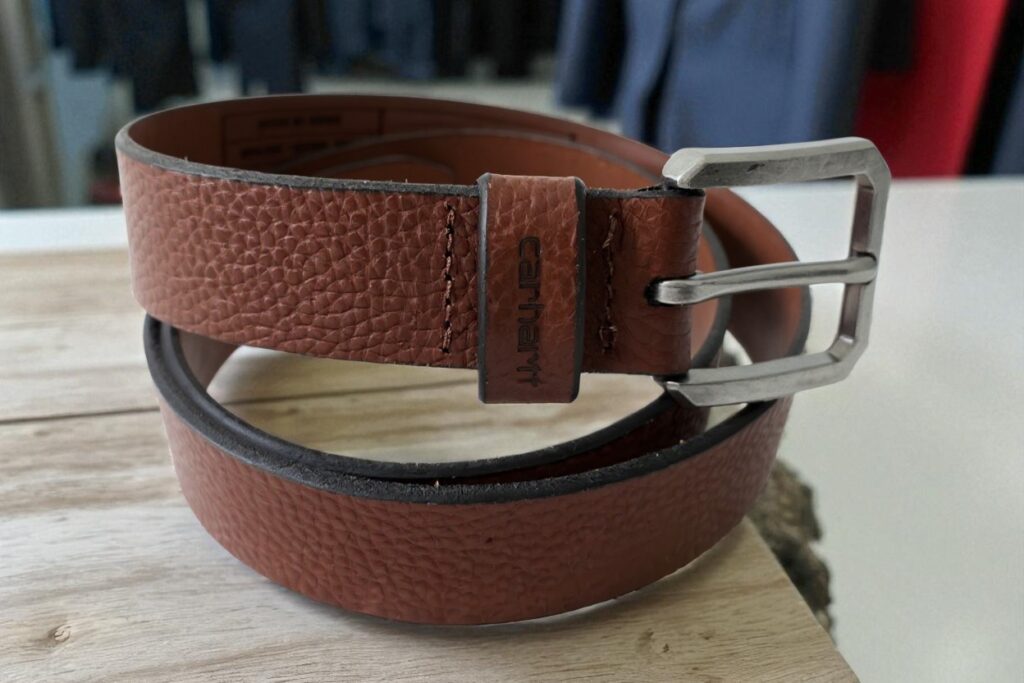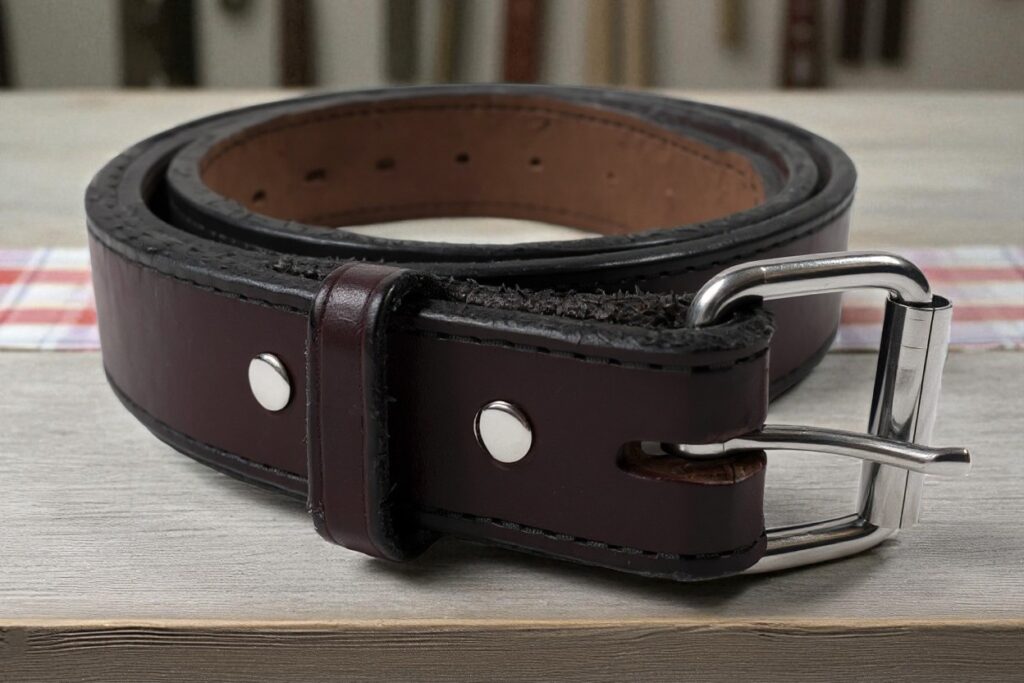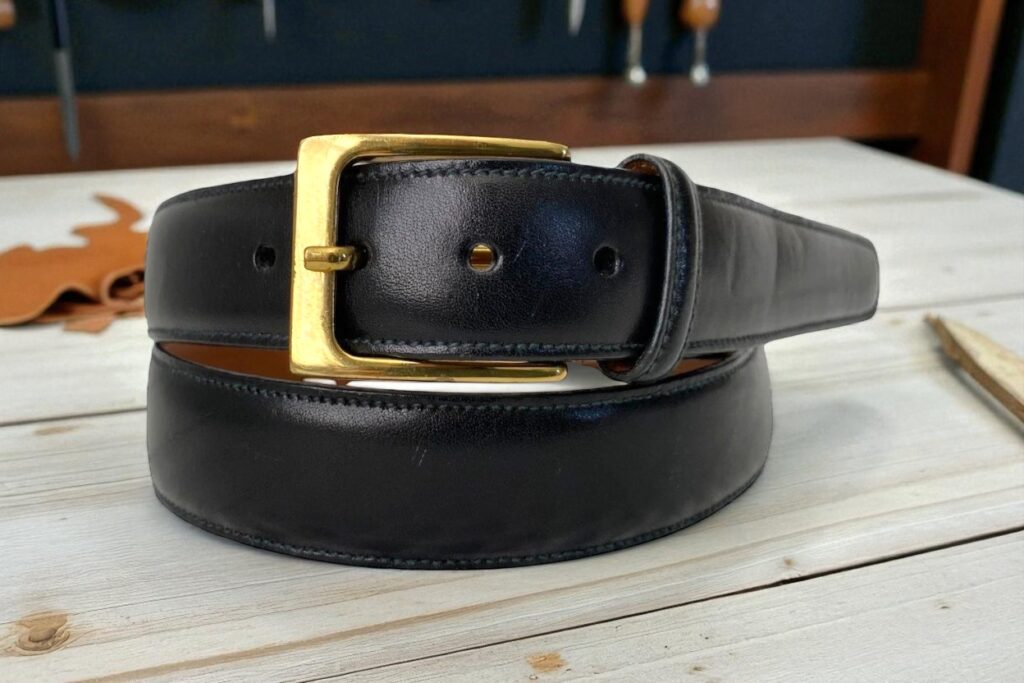Best Belt Brands for 2025: From Affordable to Premium
You know that moment when you’re getting ready for an important meeting, and you notice your belt is cracked right where it bends? Or maybe the buckle just gave up after six months of regular wear. I’ve been there, and it’s frustrating because a belt seems like such a simple thing—until you realize most of them aren’t built to last.
Here’s the thing: the belt market is crowded with brands making big promises. Some deliver genuine quality at fair prices. Others charge premium rates for mediocre products wrapped in fancy marketing. After reviewing belts across every price range, I’ve put together this guide to help you find a belt brand that matches your budget and actually holds up.
Whether you’re looking to spend $30 or $300, you’ll walk away knowing exactly which brands deliver real value and which ones to skip.
Contents
📦 Found This Gem Today
JUKMO Reversible Ratchet Belt – Finally, One Belt That Does It All
Tired of belts that never fit quite right? This clever ratchet system clicks into the perfect spot every time. Plus it's reversible – so you're basically getting two belts for the price of one.
⭐ 4.7/5 stars – 60+ happy customers
Just $19.98 (seriously good deal)
👉 Check It OutWhat Actually Makes a Belt Brand Worth Your Money
Before we get into specific brands, let’s talk about what separates a belt that lasts five years from one that falls apart in five months.
Leather quality matters more than anything else. Full-grain leather—the top layer of the hide with all its natural grain intact—ages beautifully and gets stronger over time. Top-grain leather (sanded down slightly) works fine for most people and costs less. “Genuine leather” is basically scraps glued together, and it will crack and peel within a year. If a brand won’t tell you what type of leather they use, that’s your first red flag.
The hardware tells you a lot, too. Solid brass or stainless steel buckles won’t bend or break. Zinc alloy buckles (what most cheap belts use) will literally snap in half if you catch them on something. Pick up the belt and feel the buckle’s weight—quality hardware has substance to it.
Look at how the belt is constructed. Single-layer belts cut from one thick piece of leather last longer than two thin layers glued together. Check the edges—are they finished smooth or left rough and fuzzy? The stitching should be tight and even. These details sound minor, but they’re the difference between a belt that develops character and one that just looks worn out.
One more thing people overlook: customer service and warranties. Brands confident in their quality back their products. A one-year warranty is standard. Anything less suggests they know their belts won’t hold up.
Best Affordable Belt Brands Under $50
Let’s start with brands that won’t hurt your wallet but still deliver decent quality.

1. Anson Belt & Buckle: Strong Value in Micro-Adjustable Belts
Anson’s been around long enough to earn a solid reputation among guys who’ve sworn off the whole “holes in belts” situation. Their micro-adjustable (or ratchet, if you prefer) system is clean, easy to use, and—honestly—hard to go back from once you’ve tried it. Cheaper knockoffs exist, sure, but most don’t hold a candle to how Anson builds theirs.
Price-wise, you’re usually looking at around $40 to $60 for a full belt, depending on the strap material. The premium leathers go higher, but still stay comfortably below “luxury” territory. The leather itself feels substantial—smooth, a little weighty, with that soft flex you only get after a few wears.
What really makes Anson stand out, though, is their interchangeable setup. You can buy a buckle for roughly twenty-five bucks, grab a few different straps, and suddenly you’ve got a small rotation of belts without actually owning a dozen of them. It’s clever and practical—especially if you like switching between casual and dress looks.
The buckles themselves are metal and feel solid in hand. They lock into the internal track with a satisfying little click—no slipping, no weird half-catch. Compared to budget ratchet belts, Anson’s hardware feels more polished, both literally and figuratively. Better edge finishing, steadier dye work, fewer “hmm, this feels cheap” moments.
The leather quality at this price point shows when you compare it directly to budget options. It’s noticeably thicker, the edges are beveled and burnished smooth, and the dye goes all the way through instead of just coating the surface.
Best for: People who want versatility and quality without jumping to premium prices.
2. Carhartt: Best Value Leather
Carhartt’s Detroit leather belt runs around $30-$50 and delivers exactly what you’d expect from a workwear brand—straightforward construction that holds up to daily abuse. It’s not fancy. The leather won’t develop the same rich patina as higher-end options, but it won’t fall apart either.
Carhartt mostly sticks with full-grain or top-grain leather, backed properly and reinforced with sturdy rivets. The buckle’s plain steel—functional, no frills, exactly what it needs to be. Honestly, it’s the belt version of a dependable old pickup or, as you put it, a reliable sedan. Not thrilling, but it just works.
Best for: People who need something dependable for physical work or just want a no-nonsense belt that lasts.
Best Mid-Range Belt Brands ($50-$150)
This price range is where you start seeing significant quality improvements that actually translate to how long the belt lasts and how good it looks over time.

1. Hanks Belts: Best Craftsmanship
Hanks offers many of its full-grain leather belts in the $50–$100 range, especially for models like the Gunner, Everyday, etc. Some dress or premium lines do exceed that. Because Hanks sells directly (via their site and limited distributors) and emphasizes durable materials, you get a lot of value.
At first, the leather is quite stiff (as is typical for heavier full-grain leather), but with regular wear, it softens and forms a nice patina rather than just wearing poorly. They offer a 100-year warranty, which sounds like marketing until you realize they’ve been honoring it for years.
Best for: People who want legitimate leather quality and don’t mind a 2-3 week break-in period.
2. Grip6: Best for Casual & Functional Wear
If you want something different from the classic leather belt, Grip6 makes webbing/nylon belts with aluminum, titanium, or steel-type buckles. Many of their models are priced around $50-$120, with certain premium versions going above.
The buckle system is clever: it grips the strap at any point, allowing very fine adjustment rather than forcing you into fixed holes that may be too tight or too loose.
These belts are excellent for casual wear, travel, or anyone whose waist size fluctuates. They’re less appropriate for formal business attire, but for everyday use, they offer strong value.
The nylon (or webbing material) is far more resistant to cracking or drying out than leather, does not need conditioning, and many users say they’re easy to clean (a mild rinse or gentle wash usually works).
Best for: Casual dressers, frequent travelers, and people who prefer function and comfort over tradition.
3. Allen Edmonds: Best for Business Professionals
Allen Edmonds built their reputation on dress shoes, and many of their belts (often priced around US $80-$150) uphold a comparable standard of craftsmanship. They typically use premium calfskin and other fine leathers that are well-finished and substantial, offering enough structure to maintain shape while being reasonably comfortable.
These belts look right with business attire—refined, classic, and not flashy. The leather often has a muted shine that works well in professional settings, and the buckles are designed to be understated yet durable. If you’re in a corporate environment where appearance matters, Allen Edmonds belts offer a solid balance of polish and appropriateness.
Best for: Corporate professionals who want belts that look polished immediately and will match formal dress.
4. Thirteen50 Leather: Best Versatility
Thirteen50 offers full-grain leather belts often in the US $60-$75 range (some premium or wider models may creep into the $80-$90 area). Their designs tend to work well both with jeans (especially the 1.5″ “everyday” styles) and more dressed-up looks (with their 1.25″ or more refined finishes).
Their leather feels clearly above basic budget belts, but the build is hearty enough that you won’t baby it—these are belts you can wear frequently. They keep designs classic and understated, with minimal branding or flashy elements. The buckles are simple, functional, and generally well-made.
While many users report very good consistency in leather thickness, finish, and edge work, there are scattered reports of variation—some newer models seem thinner, or burnishing less refined. But for what you pay, they are widely considered a good balance.
Best for: Someone who wants a single belt that works well across different outfits—from casual to semi-dress—without overly delicate materials or extreme prices.
Best Premium Belt Brands ($100-$200)
This is where you’re paying for exceptional leather, superior construction, and brands with decades of expertise.

1. Trafalgar: Best Investment Piece
Trafalgar Leather Goods, founded in 1972, has built a reputation for high-quality belts and accessories. Many premium models are priced in the US $100-$200 range (and some exotics or special finishes go above that), reflecting their materials and craftsmanship.
Their Cortina collection, for example, uses European vegetable-tanned calfskin, hand-antiqued and finished with care. When you handle their premium leather belts, the difference compared to cheaper belts is often noticeable—the leather has a firm yet supple feel, the color and grain tend to be even, and the stitching, edge work, and finishing details are precise.
They offer crocodile- or croc-embossed calf leathers that look high-end without being overly flashy, and many pieces feature solid, well-made hardware (though not all models have brass buckles). These belts are made to age; many users report that after five years, their Trafalgar belts look better than many cheaper belts do when new.
Best for: Someone who sees a belt as more than an accessory—someone who wants durability, style, and quality that rewards long-term ownership.
2. Ashland Leather: Best American-Made Quality
Ashland Leather is based in Chicago, Illinois, and was founded by two former Horween tannery workers. They produce belts using American-sourced Horween leathers (Chromexcel, Shell Cordovan, etc.), emphasizing craftsmanship, durability, and heritage.
Their standard belts often cost around US$125, especially for full-grain, Chromexcel, or Latigo leather offerings. Some special items (shell cordovan, limited editions) cost more.
What makes Ashland stand out are their finish options: color choices, hardware (buckles, brass), edge, and stitching details. While not every single component is custom for every belt, they offer enough variety and are transparent about their materials and manufacturing process. The makers are engaged — through their blog, social media, and FAQ, they often explain leather types, finishes, and care.
Their use of Horween Chromexcel leather is especially valued in leather-enthusiast circles — it’s known for being durable, rich in oils and waxes, developing great patina, and being more forgiving with moisture relative to many dress-grade leathers.
Best for: People who want genuinely American-made leather goods, prefer solid materials and craftsmanship, and don’t mind paying a bit more for quality and finishing options.
Best Luxury Belt Brands ($200+)
Let’s be honest about luxury belts: you’re paying for brand prestige, exceptional materials, and in some cases, designs that make a statement. Are they functionally better than a $150 belt? Not really. But there are reasons people buy them anyway.
1. Hermès: Best Heritage Brand
Hermès belts often begin in the US $600-$1000 range (or higher), depending on the style, leather, and hardware. What you get at that price is more than just a belt—you get heritage: leather from some of the finest tanneries (including ones Hermès has acquired), crafted by skilled French artisans, and buckle designs (especially the “H”) that are instantly recognizable.
The leather quality is typically exceptional: soft yet substantial, brilliantly finished, with fine attention to detail in stitching, edges, and dye. Some of their belts are reversible or come in belt-kit styles where straps and buckles can be mixed, giving versatility.
One of the major strengths is resale value—Hermès belts, especially iconic “H” models in good condition, tend to hold value far better than most belts from premium but less prestigious brands.
Reality check: you are paying a large premium not just for materials and construction, but for brand, cachet, and status. A well-made belt from a smaller or less-famous maker could last just as long in terms of durability, though it may not deliver the same prestige or recognition. If heritage, brand status, and long-term prestige matter to you, Hermès delivers strongly.
2. Gucci: Best Designer Option
Gucci belts often retail in the US $500–$700 range (some models above or below, depending on style). What you’re largely buying is a blend of premium design, brand heritage, and visual signature—especially through the iconic GG buckle, which is widely recognizable and carries strong brand equity.
The leather and hardware quality are solid for a luxury product, and many Gucci belts hold up very well over the years of use. But for that price, you may not always get materials or durability vastly superior to well-made non-designer belts—so you’re paying a premium for brand and aesthetics as much as raw quality.
These belts shine when your fashion sense, brand image, and the “look” of your outfit matter. If you’re wearing a belt more as a statement than just a utilitarian tool, Gucci delivers.
For those who prioritize quality-to-price, there are other belts (especially from heritage or niche leather artisans) that may offer closer returns on material and durability per dollar. But fashion isn’t always about math.
Best for: People who see a belt as part of their aesthetic signature and value designer cues as part of their style identity.
How to Choose the Right Belt Brand for Your Needs
Here’s how to think through this decision practically.
Match your actual lifestyle. If you wear jeans and casual shirts daily, a $300 dress belt makes no sense. If you’re in client-facing corporate roles wearing suits, investing in quality leather that looks polished matters. Be honest about how and where you’ll actually wear this.
Understand leather types quickly: Full-grain leather (best quality, ages beautifully, most expensive), top-grain leather (good quality, affordable, reliable), genuine leather (low quality, avoid). If it’s not one of these, it’s probably bonded leather or synthetic.
Check construction that matters: Single-layer beats glued layers. Solid buckles beat zinc alloy. Stitched beats glued. Finished edges beat raw edges. These aren’t just aesthetic choices—they determine how long the belt lasts.
Get sizing right: Measure a belt you currently wear from where it buckles to the hole you use. That’s your size. Most belts come in even sizes (32, 34, 36). Round up if you’re between sizes.
Belt Brands to Avoid
Some warning signs: brands that won’t specify their leather type, suspiciously cheap “genuine leather” belts at department stores (they’ll crack within months), belts with massive logos (you’re paying for marketing), and anything where the price seems detached from the actual materials and construction.
Fast fashion brands generally make poor belts. They look okay initially, but fall apart quickly. The leather is thin, the hardware is cheap, and there’s no longevity.
Caring for Your Belt Investment
Store belts hanging or rolled loosely—never folded tightly. Clean leather belts with a damp cloth and condition them every few months with proper leather conditioner. Don’t wear the same belt daily—rotation helps them last longer.
When the leather starts cracking near the buckle or the holes stretch too much, it’s time to replace it. A quality belt should give you 5-10 years of regular wear, depending on use and care.
